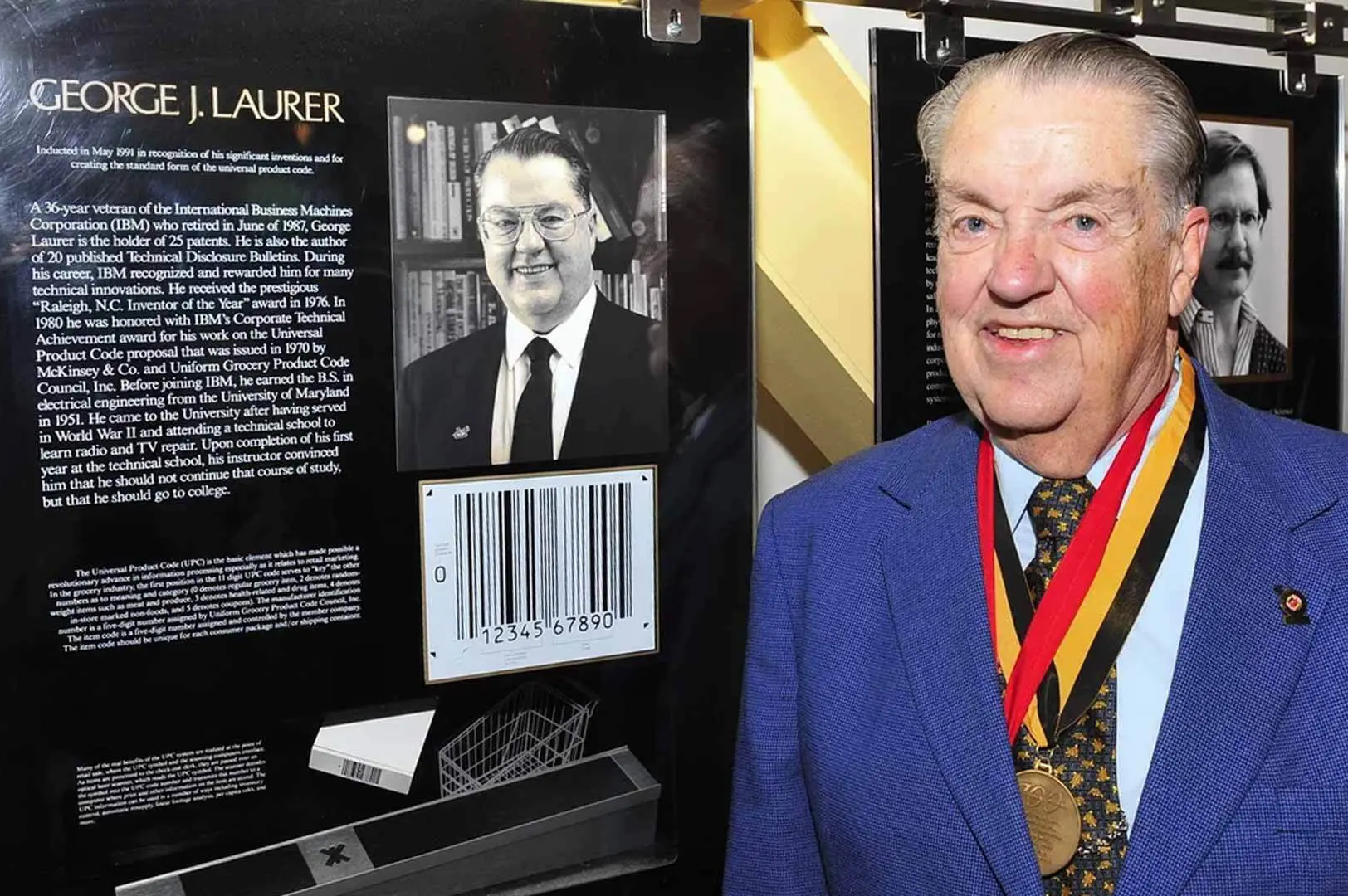News Story
Bar None: How a Terp Invented One of the Biggest Innovations in Retail

George Laurer '51, inventor of the Universal Product Code, is shown at the A. James Clark School of Engineering's Innovation Hall of Fame in 2011. He was inducted 20 years earlier. Photo by Al Santos/University of Maryland
Story by Maggie Haslam for Maryland Today.
Shoppers breezing through a Target self-checkout, eyeing the dizzying array of jarred spaghetti sauce at Safeway or comparing tank tops on Amazon may not register the rectangular, 12-digit miracle that makes their purchases possible—or the University of Maryland alum who created it.
But 50 years ago on Wednesday, the Universal Product Code (or UPC) irrevocably transformed the global economy—and the consumer experience as we know it—with the swipe of a 67-cent pack of Wrigley’s gum in a Troy, Ohio, grocery store. Today, it can be found on plane tickets, comically large packages of paper towels and pouches of donated blood. Young people tattoo it on their bodies to be ironic, and Christian fundamentalists claimed to find the “mark of the beast” lurking in the code.
The far-reaching impacts of the UPC likely didn’t occur to George Laurer ’51 when he devised the series of black bars and spaces; he simply wanted to make shopping faster and pricing more accurate.
“It was cheap, and it was needed. And it is reliable,” Laurer, who died in 2019, told The New York Times in 2009. “Those three things probably contributed more than anything else.”
A World War II veteran who initially set his sights on a career in television repair, Laurer enrolled in UMD’s electrical engineering program with the encouragement of one of his vocational instructors. After graduating, he began a 36-year career with IBM, where he devised many inventions and patents, including machines for the Canadian census and standardized testing, and a podium that debuted during the Eisenhower administration, equipped with a bulletproof shield that the Secret Service could activate (an early demonstration thrust the shield upward so forcefully it lifted the podium off the ground).
But one of his earliest assignments was to develop an optical product code based off a “bull’s-eye”-shaped design engineers had been tinkering with for several years; when Laurer discovered it was prone to smudging in a high-speed printing press, he and his team devised a series of stripes punctuated by numbers at the bottom.
IBM placed the code in the public domain to pave the way for the company’s other retail revelation, the electronic scanner, which Laurer dedicated much of his career to refining. Because the code was never patented, he never received royalties.
“If he even got a fraction of a penny per scan, we’d be the wealthiest family on the planet,” said Laurer’s son, Craig. “That never seemed to bother my dad. For him it was just his job.”
Laurer didn’t receive accolades for his role in creating the UPC until he was honored with a special achievement award from IBM in the 1980s. He was inducted into UMD’s Engineering Hall of Fame in 1991 after his family goaded him into answering the call for nominations; he reluctantly put “invented the universal product code” on the application.
Decades after the scanner made its way into retail stores, Craig took his dad to his local Stop N Shop in Connecticut to see the grocery chain’s latest consumer convenience: the self-scanner, based off Laurer’s patent of the hand-held scanner.
“He was so impressed, even though, honestly, it didn’t work that well!” Craig laughed. “But he just had to see it.”
The UPC was a game changer in every facet of the retail industry, said Joe Bailey, an associate research professor at UMD’s Robert H. Smith School of Business. It eliminated common problems wrought by manually adding prices to products in stores with a pricing gun or by hand: mismarked products, label swapping and cashier errors.
The code, he said, also expanded the variety of products a store could carry; the elimination of manual pricing meant stores could stock a lot more items without adding much labor (the average grocery store inventory has more than tripled in 50 years), eventually paving the way for big box stores and e-commerce. UPCs can help companies track where items are selling well, said Bailey—if there’s a run on Flamin’ Hot Cheetos at the Laurel, Md., Walmart, Frito-Lay can divert product from a nearby store. The codes can also locate stale or recalled products and allow real-time price adjustments.
“In a hyper-inflation environment where prices may fluctuate several times a week, it’s not as big a deal,” said Bailey.
The advent of QR codes—which can offer more product information and consumer extras, like recipes—will soon overtake the UPC; retailers in Europe and the U.S. have already begun the transition to widely accept QR codes everywhere by 2027. But for Craig Laurer and his siblings, the code was never their dad’s legacy. A lifelong tinkerer, from customizing furniture and the family RV to swiftly winding rubber-band rockets with a hand-cranked drill for his sons’ Boy Scout troop, Laurer found joy in making things better for everyone.
“He was the greatest dad,” said Craig. “He was always doing stuff like that and didn’t expect anything in return.”
Published June 26, 2024









